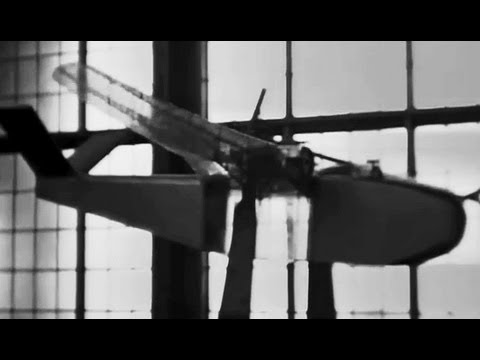Flutter (Aerodynamics) circa 1940 NACA Langley Research Center; Aeronautical Engineering
more at
“Aircraft flutter was responsible for a number of plane crashes. This video illustrates each of the separate modes of vibration possible for a wing to execute. NASA Langley Research Center Film #336.” Silent.
See also:
“Flutter at a Glance”
“Aeroelasticity Matters”
Public domain film from NASA, slightly cropped to remove uneven edges, with the aspect ratio corrected, and mild video noise reduction applied.
Aeroelasticity is the science which studies the interactions among inertial, elastic, and aerodynamic forces. It was defined by Arthur Roderick Collar in 1947 as “the study of the mutual interaction that takes place within the triangle of the inertial, elastic, and aerodynamic forces acting on structural members exposed to an airstream, and the influence of this study on design.” In more simple terms, it is the same set of conditions causing a flag to flutter in a stiff breeze or a reed to tremble in fast-flowing water. Flutter may occur in any fluid medium…
Introduction
Airplane structures are not completely rigid, and aeroelastic phenomena arise when structural deformations induce changes on aerodynamic forces. The additional aerodynamic forces cause an increase in the structural deformations, which leads to greater aerodynamic forces in a feedback process. These interactions may become smaller until a condition of equilibrium is reached, or may diverge catastrophically if resonance occurs.
Aeroelasticity can be divided in two fields of study: steady (static) and dynamic aeroelasticity…
Dynamic aeroelasticity
Dynamic Aeroelasticity studies the interactions among aerodynamic, elastic, and inertial forces. Examples of dynamic aeroelastic phenomena are:
Flutter
Flutter is a self-feeding and potentially destructive vibration where aerodynamic forces on an object couple with a structure’s natural mode of vibration to produce rapid periodic motion. Flutter can occur in any object within a strong fluid flow, under the conditions that a positive feedback occurs between the structure’s natural vibration and the aerodynamic forces. That is, the vibrational movement of the object increases an aerodynamic load, which in turn drives the object to move further. If the energy input by the aerodynamic excitation in a cycle is larger than that dissipated by the damping in the system, the amplitude of vibration will increase, resulting in self-exciting oscillation. The amplitude can thus build up and is only limited when the energy dissipated by aerodynamic and mechanical damping matches the energy input, which can result in large amplitude vibration and potentially lead to rapid failure. Because of this, structures exposed to aerodynamic forces — including wings and aerofoils, but also chimneys and bridges — are designed carefully within known parameters to avoid flutter. In complex structures where both the aerodynamics and the mechanical properties of the structure are not fully understood, flutter can only be discounted through detailed testing. Even changing the mass distribution of an aircraft or the stiffness of one component can induce flutter in an apparently unrelated aerodynamic component. At its mildest this can appear as a “buzz” in the aircraft structure, but at its most violent it can develop uncontrollably with great speed and cause serious damage to or lead to the destruction of the aircraft, as in Braniff Flight 542.
In some cases, automatic control systems have been demonstrated to help prevent or limit flutter-related structural vibration.[citation needed]
Flutter can also occur on structures other than aircraft. One famous example of flutter phenomena is the collapse of the original Tacoma Narrows Bridge.
Flutter as a controlled aerodynamic instability phenomenon is used intentionally and positively in wind mills for generating electricity and in other works like making musical tones on ground-mounted devices, as well as on musical kites. Flutter is not always a destructive force; recent progress has been made in small scale (table top) wind generators for underserved communities in developing countries, designed specifically to take advantage of this effect. Peter Allan Sharp (of Oakland, California) and Jonathan Hare (of University of Sussex) demonstrated, in March 2007, a linear generator run by two flutter wings. The wind energy industry distinguishes between flutter wings, flip wings, and oscillating tensionally-held sweeping membrane wings for wind milling…

